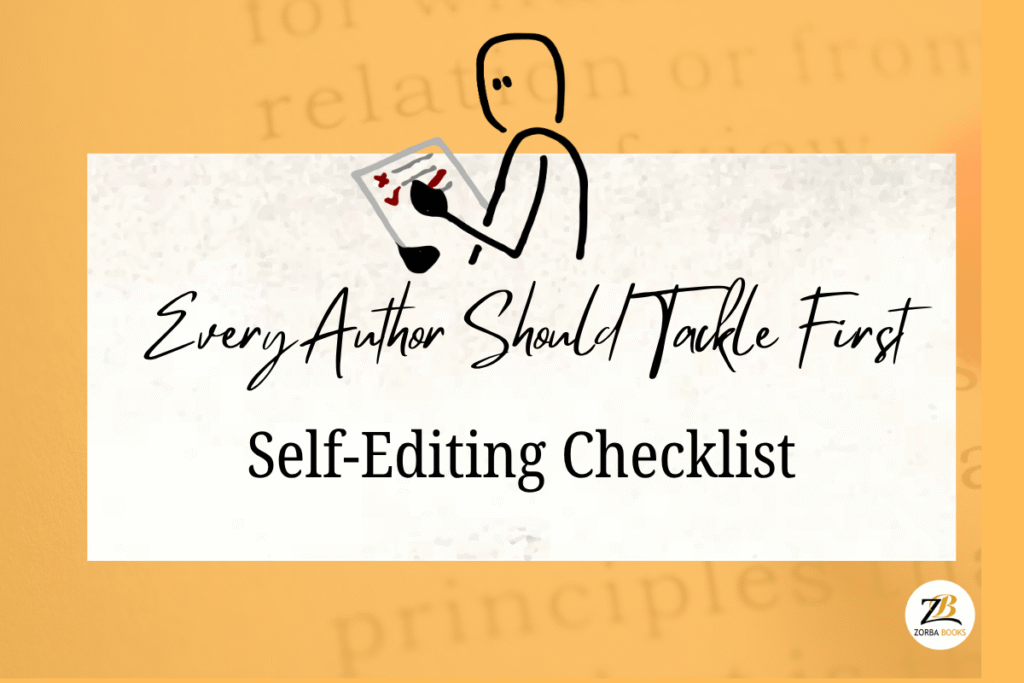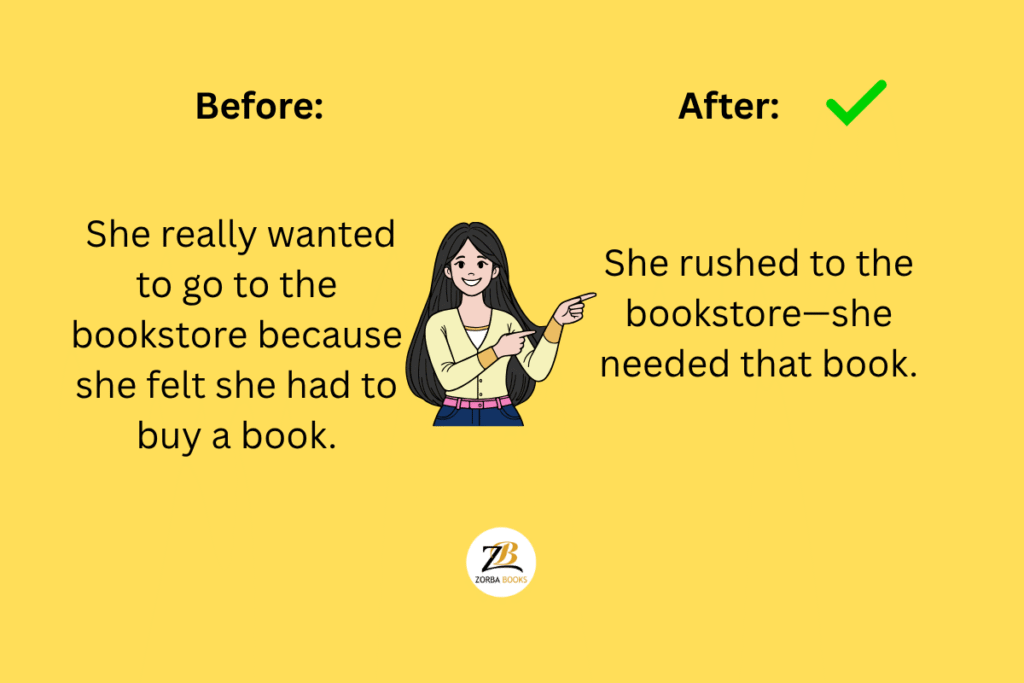
Why Self-Editing Matters Before You Publish a Book
Whether you’re pursuing traditional publishing, working with independent publishers, or partnering with leading book publishers in India like Zorba Books, one step remains non-negotiable: the self-editing process for authors. It’s not just a polish—it’s part of your professional evolution as an author.
The self-editing process for authors bridges the gap between your first draft and a finished manuscript worthy of publication. Before your words go public—whether in print, eBook, or open access format—this step enhances clarity, improves pacing, and sharpens your unique narrative voice.
Take it seriously, and you’ll rise among the ranks of bestselling authors.
- Step One: Pause, Then Read Like a Stranger
- Self-Editing Process for Authors: Your Step-by-Step Revision Plan
- Self-Editing revision checklist for authors
- Understanding Line Edit vs Developmental Edit
- Trim the Fat: Tighten Your Sentences
- Dialogue That Feels Real
- Proofreading Tips for Authors: The Final Polish
- Bonus: Self-Editing Tools to Keep Handy
- Your Final Self-Editing Mantra: Be Ruthless, Then Be Proud
1. Step One: Pause, Then Read Like a Stranger
After typing the last line of your manuscript, take a break. A few days’ distance lets you return to your work with objectivity, like a first-time reader. Change the font, print a few chapters, or read sections aloud. You’ll immediately notice inconsistencies and awkward phrasing that weren’t visible before.
2. Self-Editing Process for Authors: Your Step-by-Step Revision Plan
Here’s a carefully structured revision checklist for writers designed to help you self-edit your novel step by step before approaching book publishers or preparing for self-publication.
Stage 1: Developmental Editing
Focus: Plot, pacing, structure
Ask: Is the storyline cohesive? Are subplots resolved? Are there gaps in logic or pacing?
Stage 2: Character Consistency
Focus: Growth, motivation, believability
Ask: Does each character evolve meaningfully? Do their actions reflect their motivations?
Stage 3: Scene Purpose
Focus: Relevance, emotional stakes
Ask: Does each scene move the story forward? Can it be trimmed without losing impact?
Stage 4: Line Editing
Focus: Style, voice, sentence clarity
Ask: Are my sentences engaging? Is my tone consistent throughout?
Stage 5: Proofreading
Focus: Grammar, spelling, punctuation
Ask: Are there typos, formatting errors, or inconsistencies?
3. Self-Editing revision checklist for authors, especially useful if you’re looking to self-edit a novel step by step:
| Editing Stage | Focus Area | What to Ask Yourself |
| 1. Developmental Edit | Structure, plot, pacing | Does the story flow logically? Are there plot holes or underdeveloped arcs? |
| 2. Character Consistency | Motivation, growth, believability | Do characters evolve? Are their actions justified and consistent? |
| 3. Scene Purpose | Relevance, tension, transitions | Does each scene move the story forward or reveal something essential? |
| 4. Line Editing | Sentence clarity, tone, rhythm | Are your sentences fluid and engaging? Is your voice consistent? |
| 5. Proofreading | Grammar, punctuation, spelling | Are there typos, missing words, or formatting issues? |
4. Understanding Line Edit vs Developmental Edit
These terms often confuse first-time authors. A developmental edit focuses on big-picture issues—story arcs, character development, narrative structure. A line edit, on the other hand, polishes language at the sentence level.
Example: Zorba Books recently worked with an author who wrote a compelling fiction and non fiction hybrid. Though her ideas were powerful, theself-editing process for authors manuscript required both developmental restructuring and line-level refinement. After following a layered editing process, her book in English became a standout success among independent publishing projects.
Character Arcs: The Emotional Core of Great Stories
Indian readers respond to emotionally rich characters. Ask yourself: Is my protagonist’s journey transformative? Can readers see internal conflict and evolution? Strong arcs are why characters like Balram Halwai in “The White Tiger” or Lata Mehra in “A Suitable Boy” linger in our memories.
5. Trim the Fat: Tighten Your Sentences
Once your plot is locked, begin the internal cleanup. Replace overused words and weak verbs. Cut filler words like “just,” “really,” and “very.” Eliminate redundancy.

Before: She really wanted to go to the bookstore because she felt she had to buy a book.
After: She rushed to the bookstore—she needed that book.
This attention to detail separates aspiring writers from publishing-ready authors.
6. Dialogue That Feels Real
Good dialogue reads like real speech—with rhythm and subtext. Avoid monologues or over-explaining. Each character should have a unique voice and reflect the culture, background, or linguistic nuances true to your story.
Author R.K. Narayan’s dialogues in “Swami and Friends,” for instance, feel authentic to Malgudi’s world—simple, clever, and grounded in cultural context.
7. Proofreading Tips for Authors: The Final Polish
Before submitting to book publishers or listing your work through a self-publishing platform, complete a final proofing round.
- Read aloud to catch clunky phrasing
- Use free tools like Grammarly or Hemingway, but don’t rely solely on them
- Check for consistency in spelling (especially Indian vs. American English), punctuation, headers, and formatting
- Ask a trusted friend or writer to be your second pair of eyes
8. Bonus: Self-Editing Tools to Keep Handy
- Hemingway Editor for tightening prose
- ProWritingAid for grammar, style, and readability
- Google Docs “voice typing” to catch awkward pacing
- Scrivener for organizing chapters and notes
a. Real-World Example from Indian Publishing
An emerging author from Bengaluru recently partnered with Zorba Books after self-editing her debut romance novel. She followed a detailed checklist, focusing first on structure and later on sentence rhythm and tone. Because her manuscript was clean, our editorial team could invest time in fine-tuning rather than starting from scratch. Today, her book is available across India and digital platforms through one of the most reliable book publishing houses.
b. Self-Editing Benefits for Every Publishing Path
Whether you plan to submit to a publishing group, an academic press with open access formats, or release it through a hybrid model, quality matters. Book publishing houses expect manuscripts that show promise—and polish.
Moreover, if you’re publishing through an independent publisher or entering a curated publishing program, self-editing saves time, cuts costs, and increases your credibility.
c. Why It Matters More in Today’s Publishing Industry?
In a fast-changing publishing industry, authors must wear multiple hats—storyteller, marketer, researcher. A rigorous self-edit demonstrates your commitment to quality and your understanding of professional standards. And when you combine that effort with a strategic marketing plan, you increase your chances of becoming one of tomorrow’s bestselling authors.
9. Your Final Self-Editing Mantra: Be Ruthless, Then Be Proud
This process isn’t about being overly critical—it’s about elevating your work. Take the time now, and you’ll save countless hours during professional edits or revisions requested by book publishers.
Whether your manuscript is intended for traditional publishing or a digital-first indie release, self-editing turns potential into power.
a. Call to Action: Submit a Polished Manuscript with Confidence
Ready to move from manuscript to published book? Zorba Books offers editorial consultations, marketing support, and end-to-end publishing services for authors writing in English across genres.
Visit zorabooks.com to submit your manuscript or explore our author services. Together, we’ll help you reach a wider audience—on your terms.
b. Closing Thought: Self-Edit Like a Professional to Publish with Purpose
By following this self-edit novel step by step guide, you’ve already taken your first step toward professional book publication. With time, care, and attention to structure, language, and style, your manuscript won’t just be readable—it will be unforgettable.
If you found this guide helpful, consider sharing it with fellow authors or creators in your network. It might be just the spark they need for their successful self-editing of the manuscript.
Pingback: Book Publication Strategy: Number of Pages in a Book I Zorba
Pingback: Best Apps for Writing Your Book I Zorba Books
My gratitude to ZorbaBooks knows no bounds. If I am beginning to make my mark in the literary world today, due credit should be given to this publishing house for guiding me through every step of my writing journey.
I learned a lot from ZorbaBooks through articles like the one above. This article is going to be extremely useful as I am about to sign my first Writing Contract in the next couple of days and the write-up will help me immensely in presenting a neat manuscript to the publisher.
I wish ZorbaBooks all the very best of Luck, Happiness and Success. God bless.
Thank you for your positive feedback. We hope that these articles will help many more writers. We wish you all the best in all your endevours.
Pingback: Complete Guide to Hybrid Publishing in India I Zorba Books
Pingback: Most Misused Idioms and Phrases in English: Meanings and Correct Usage - ZorbaBooks